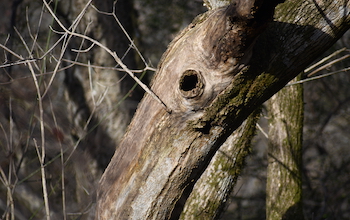
By Terry W. Johnson
I have long been intrigued by relationships that often unwittingly link different species of wildlife to one another. One such association exists between woodpeckers and a suite of unrelated birds that inhabit woodlands and backyard habitats across Georgia.
I am referring to the well-known fact that cavities chiseled out by woodpeckers are frequently used by birds that cannot excavate their own nesting sites. These cavities are created in dead limbs and dead and dying trees. Yet in truth, the sites also provide critical winter roosting habitats for birds that roost in cavities during winter. Extremely cold temperatures at this time of year are particularly threatening to these birds. Being able to find suitable nighttime roost sites where they can escape frigid winds and temperatures can spell the difference between living and dying.
Unfortunately, since there is a shortage of suitable winter roosting cavities, it is difficult if not impossible for many cavity-roosting birds to find a safe haven to escape cold weather.
There are many reasons why the availability of natural roosting cavities falls far short of the demand for them. Each year, untold numbers of cavities (natural ones and those created by woodpeckers) disappear when thousands of acres of woodlands are logged, transformed into croplands, shopping centers, highways and housing developments. In addition, before winter arrives, competition for the remaining cavities is keen. Most are claimed by birds that either bred locally, thus their young don’t have a chance to compete for them, or were otherwise here long before migrants that winter in Georgia showed up to vie for the sites. In addition, birds must share cavities with other wildlife, such as flying squirrels.
The list of the winter backyard birds that use cavities as roosts in winter includes eastern bluebirds, Carolina chickadees, brown-headed and white-breasted nuthatches, tufted titmice, Carolina and winter wrens, northern flickers and other members of the woodpecker clan (downy, hairy, pileated, red-bellied, and red headed). Even blue jays have been known to seek shelter from the cold in cavities.
Surprisingly, the yellow-bellied sapsucker is absent from this list: They usually roost on the sides of trees during winter.
For all practical purposes, the only birds on this list capable of excavating their own cavities are the woodpeckers, Carolina chickadees and brown-headed nuthatches. I should note that all of these birds excavate their cavities in dead trees and limbs. These birds use tree cavities for both nesting and roosting. Woodpeckers, such as the pileated, downy and hairy, hollow out separate cavities for nesting and roosting. In the case of pileated woodpeckers, a pair will use one nest cavity a year (after one use, they abandon it). However, a single pileated woodpecker may create four to 12 roosting cavities each year.
For downy woodpeckers, the cavities it excavates during fall to serve as roost sites typically face away from the prevailing wind. Those made at other times of the year are randomly oriented. It is believed the orientation for the fall work on cavities is because in winter, the interiors of cavities facing the prevailing wind get colder than those facing away from cold winds.
A bird that roosts in a cavity during the winter has a better chance of survival than when it is forced to spend a frigid night elsewhere. It behooves a bird to use the same cavity night after night. If it has to try to find a roosting cavity as the winter sun is setting, or defend its roosting site from others, it is forced to expend invaluable energy needed to survive the night.
Cavities are extremely important because they insulate birds from the deleterious effects of cold and wind. The overnight temperature inside a cavity can be 18 or more degrees warmer than the ambient temperature outside. Much of this heat is generated by the birds' bodies. In addition, the chilling effect of wind is dramatically reduced. These factors enable birds roosting in natural cavities to expend less energy to stay alive. The impact of these savings can be dramatic. It has been calculated that it can enable a roosting bird to go an additional 5.7–7.3 hours without eating. For many birds, these precious few hours enable them to live to see the dawn.
Cavity roosting birds exhibit some interesting habits. Downy woodpeckers, for example, roost alone. Northern flickers often roost in pairs. Other species roost in large groups. A dozen or more bluebirds have been seen roosting together. Twenty-nine white-breasted nuthatches were spotted piling into one nighttime roost. Remarkably, although the winter wren does not nest in cavities, it roosts in them. Believe it or not, 46 winter wrens were spotted entering the same winter roosting cavity.
If you find dead limbs or trees on your land that do not pose a threat to humans or property, leave them be. Likewise, if you do not have any natural roosting sites on your land, erect one or more roosting and nesting boxes. These manmade cavities can help alleviate the cavity shortage in winter.
Although winter roosting cavities are often overlooked, they are a critical habitat component for many of our birds. Without them, some birds simply cannot survive the rigors of winter. If we lose them, the fabric of the lives of those of us who enjoy nature is left tattered. And we are poorer for it.
Terry W. Johnson is a former Nongame program manager with the Wildlife Resources Division and executive director of The Environmental Resources Network, or TERN, friends group of the division’s Nongame Conservation Section. (Permission is required to reprint this column.) Learn more about TERN, see previous “Out My Backdoor” columns, read Terry’s Backyard Wildlife Connection blog and check out his latest book, “A Journey of Discovery: Monroe County Outdoors.”




















